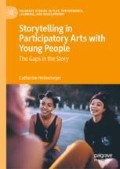Abstract
Starting with a peculiar and rather bleak folktale, Italo Calvino’s Wormwood, the author worked with a small group of young people through storytelling, poetry and puppetry to flesh out the characters’ motivations, and give the central character a right of reply to all who tormented her. The process became a joint investigation of the uses of epic narrative, demonstrating that a faraway story can provide territory for a meeting of very diverse personal perspectives. The very sparseness of most folktales, lacking any explanation of why characters act as they do, allows scope for participants to use them to tell their own stories, or to clarify their beliefs and values. A practical exercise provides the reader with the chance to explore their own creativity in the ‘gaps’ of a story.
Access this chapter
Tax calculation will be finalised at checkout
Purchases are for personal use only
References
Bakhtin, M. (1981). Epic and novel. The dialogic imagination (pp. 1–45). Austin: University of Texas.
Benjamin, W. (1973). The storyteller: Reflections on the works of Nikolai Leskov. In H. Arendt (Ed.), Illuminations (pp. 83–109). London: Fontana.
Bishop, C. (2004). Antagonism and relational aesthetics. October Magazine, 110, 51–79.
Bishop, C. (2012). Artificial hells: Participatory art and the politics of spectatorship. London: Verso.
Calvino, I. (1956). Italian folktales. London: Penguin Classics.
Godwin, I. (2015). Project Wormwood (Blog post). https://upsidedownchronicles.com/2015/07/04/project-wormwood/. Accessed August 2018.
Rorty, A. O. (1976). A literary postscript: Characters, persons, selves, individuals. In A. O. Rorty (Ed.), The identity of persons. Berkeley: University of California Press.
Thompson, J. (2011). Performance affects: Applied theatre and the end of effect (2nd ed.). London: Palgrave Macmillan.
Tolkien, J. R. R. (1966). On fairy stories. In The Tolkien Reader. New York: Ballantine Books.
Williamson, D., & Williamson, L. (1992). Land of the seal people. Edinburgh: Birlinn Ltd Publishers.
Zipes, J. (1995). Creative storytelling: Building community, changing lives. London: Routledge.
Author information
Authors and Affiliations
Corresponding author
Rights and permissions
Copyright information
© 2020 The Author(s)
About this chapter
Cite this chapter
Heinemeyer, C. (2020). The Arresting Strangeness of Wormwood: Or, The Territory of Story. In: Storytelling in Participatory Arts with Young People. Palgrave Studies In Play, Performance, Learning, and Development. Palgrave Macmillan, Cham. https://doi.org/10.1007/978-3-030-40581-6_5
Download citation
DOI: https://doi.org/10.1007/978-3-030-40581-6_5
Published:
Publisher Name: Palgrave Macmillan, Cham
Print ISBN: 978-3-030-40580-9
Online ISBN: 978-3-030-40581-6
eBook Packages: Literature, Cultural and Media StudiesLiterature, Cultural and Media Studies (R0)

